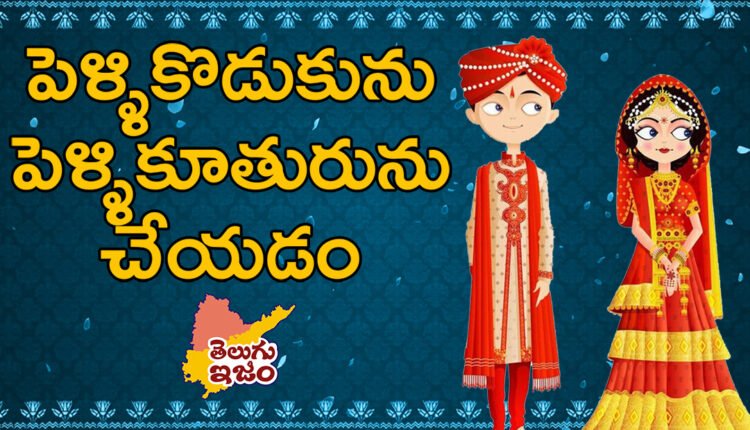Pellikodukunu Pellikuturunu Cheyadam : An Importance & Happy Event In Marriage
Pellikodukunu Pellikuturunu Cheyadam : The wedding rituals begin in the morning with Mangal baths. In the homes of the bride and groom, as the morning dawns, the ceremony of creating a mango leaf arch in front of the house accompanied by the music of Mangala instruments takes place. A palm canopy is erected in front of the house and adorned with colored papers. The area beneath the canopy is cleaned and wiped with fresh water. A beautiful muggu (rangoli) made of rice flour is created and decorated with yellow saffron.
Two peetas (small pedestals) are placed on the muggu, and a white cloth is laid over them, sprinkled with aakshintas (sacred rice grains). Mango leaf arches are then tied to the door and the canopy using mela talas (decorative ropes). The harathi (ceremonial plate with lamps) is prepared with all the necessary items such as kundlu (earthen lamps), oil, and fire.
Turmeric is applied to the bride’s legs, a bindi (dot) is placed on her left cheek, and a pair of leaves, betel nuts, and bananas are kept in the tambulam (betel leaf plate), which she holds in her hand. She is seated on the pedestal facing east, without the need for a bath. The elderly members of the family apply turmeric paste to the bride, the bride-giver couple, and the daughter-in-law (the bride’s own sister or a lineal sister). They give Harathi (a ritual to ward off evil) and prepare for the Mangala baths.
The groom sits on the left side of the bride. Relatives and guests sing aarti and seek blessings from the couple. Akshinthas (sacred rice grains) are showered on them, and Harati is performed. Both the bride and groom wear new clothes and have ghee applied to their hands and feet. A paste made of water and gram flour is applied to their hands and face.
Pellikodukunu Pellikuturunu Cheyadam & Tradition
As part of a playful tradition, yellow betel leaves or yellow horns are tied to five bundles of thread, resembling bows. Five turmeric horns are placed in the roti (bread) and pounded by five Muttaidhus (married women). The pounded turmeric is gently added to the Talambra rice.
A wet towel is placed on a plate, and gouramma (a representation of Goddess Parvati) is made with turmeric and placed on the betel leaves on the plate. A chain is also offered to Gauramma, and Gauri Puja is performed. After the puja, Vadiyas (decorative patterns) are created on the pedestal using minapa flour or gram flour by five or nine Muttaidhus.
The bride’s cousins are given bangles (as a symbol of blessings). The girl wears 11 bangles on her right hand and 10 bangles on her left hand, totaling 21 bangles on both hands combined. After bathing, everyone wears new clothes and sits on pedestals with parani (platform for the feet), flowers on their heads, and tambulas (betel leaves and areca nuts) in their hands.
The same rituals are performed for the groom, his parents, and his younger brother. It is believed that Narayana (a form of Lord Vishnu) enters into the child at birth, which is why it is said that the groom gains the wedding art. The groom, as a manifestation of Vishnu, is believed to support the bride in all her endeavors. It is customary to have a slight time difference between making a boy a bride-groom and a girl a bride, preferably at least 10 minutes.
Also Read : Gauri Puja : A Belief Of Divine & Spirituality In Hindu Tradition

